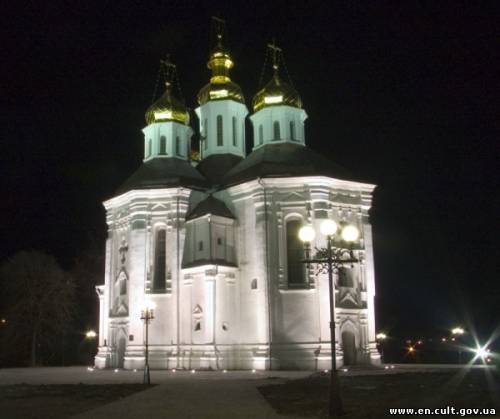 This monument to the past is located in the central part of historic town near the Dytynets and Kyiv-Chernihiv motorway. It is one of the leading architectural dominants of the city.
This monument to the past is located in the central part of historic town near the Dytynets and Kyiv-Chernihiv motorway. It is one of the leading architectural dominants of the city. It was built in honor of heroism of Chernihiv regiment Cossacks showed up during the assault of turkey fortress Azov in 1696 under the commandment of Chernihiv colonel Yakiv Lyzohub. The church was sanctified in 1715 in honor of St. Сatherine, who had been respected in Ukraine for a long time.
St. Catherine church hasn’t had great changing. In 1837 the narthex was built to the western façade of the church and the bell tower was erected in 1908 (both were taken apart during the restoration in 1951). It suffered losses in 1941 – 1943 (roofs and the tops of domes were burnt). The restoration works were conducted into 2 phases: 1947 – 1955; 1975 – 1980.
The church is made of bricks, it is cross-shaped, nine-fraction, five-dome. The composition is centrical, pyramidally built: with the highest central dome, and lower ones – over the faceted sleeves of architectural cross. So, its composition reminds a wooden Ukrainian church with five octahedral capacities – octahedrons each crowned with dome combined in one plastic unity. Thanks to such pyramidal construction the church looks tender, elegant and solemn.
The facades are a characteristic feature of the church. The main role in their decoration is played by portal and windows margins: triangular pediments, frames, shallow-cut cornices. Modelled ornamentation is not used in the church, common and circle brick, which replaced plinth, is used both as building and ornamental material. The façades are plastered and limed.
The characteristic feature of the interior is its opening upwards. It is a five-chamber pillarless temple crowned by five domes. The top is designed in traditional Ukrainian style – with fractures. The walls are whitewashed. The domes and crosses are gilded
St. Catherine church in Chernihiv is the greatest monument of Ukrainian (Cossack) renaissance of the XVII-XVIII centuries, which has authentically remained; it produced decisive influence on the development of Ukrainian church architecture of the XVIII century and it still plays the role of city building dominant of the historic part of the town.





























